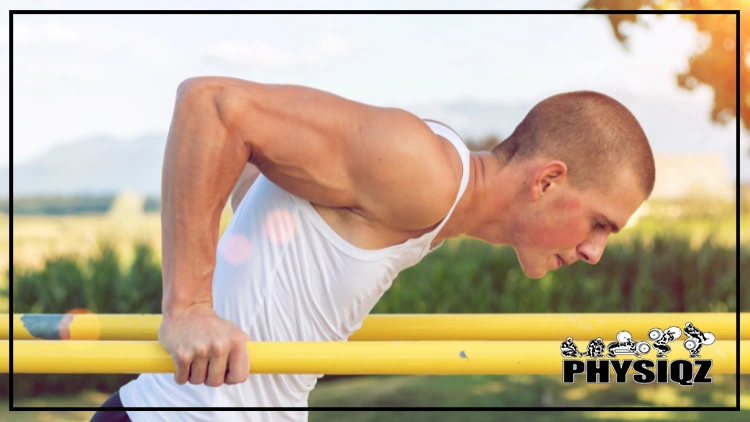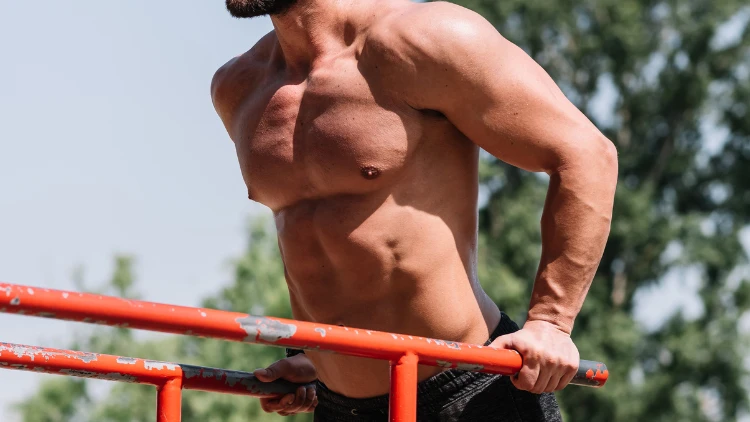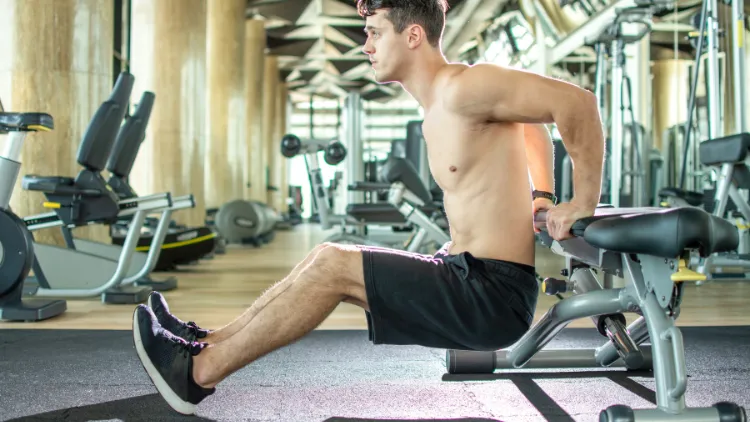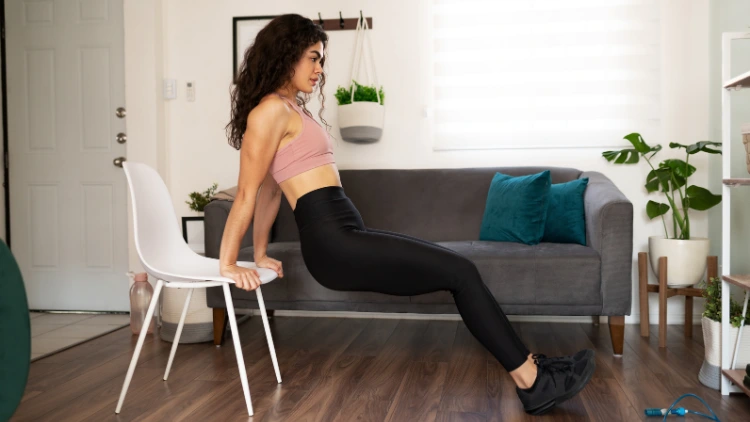
Dips are a versatile exercise that targets several muscle groups, including the chest, arms, and back. Within these broader categories, specific muscles can be engaged through different variations of dips, such as chair dips, tricep dips, and bench dips. Each type provides a unique stimulus, but achieving a deep stretch during the exercise maximizes the benefits regardless of the variation chosen.1
So with this in mind, let’s explore each type of dip, the muscles worked in each, and the various techniques to target a particular muscle group. In addition, we’ll cover how many dips is best for muscle growth, how dips compare to push ups, if dips target the upper or lower chest and how to intelligently use dips in a workout program.
Exploring the Muscles Targeted by Dips
Dips are compound movements which mean they work a myriad of muscle groups at the same time, some more than others, depending on how they are performed. Overall, dips recruit the following muscles:
Chest muscles—both the pectoralis major and minor are worked and these are the primary target muscles.
Arm muscles—in particular, the triceps brachii which provide assistance to the chest muscles.
Shoulder muscles—the anterior deltoids or the front shoulder muscles provide support to the chest as well stabilization.
Back muscles—a number of back muscles also provide assistance to the chest muscles. These are the rhomboids (bilateral muscles located at the upper back), levator scapulae (slender muscles located at the rear and sides of the neck), latissimus dorsi (flat muscles that are on the sides and behind the arm), teres major (thick rectangular muscle in the upper limb connecting the shoulders to the upper arm) and the trapezius (triangular muscle covering the neck and upper back of the shoulders) which provides stabilization.
Glutes and core muscles—both glutes and core muscles also help provide stability throughout the movement.
Dips are a weighted calisthenics exercise that improves muscle strength and involve large muscle groups using minimal equipment, mostly body weight although metal plates can be used to add to intensity.2

Source: Dziggyfoto via Canva.com3
They are also a type of kinetic chain exercise—kinetic chain exercises involve pressing the hand or feet against an immobile surface which is beneficial, since it stimulates antagonistic muscle groups consecutively, while still isolating the target muscles thus improving the dynamic balance.4
Few movements can result in upper body development and strength as dips confer so much so that they have been christened by some as upper body back squats.
This exercise comes in several variations but in terms of mechanics, they are all executed using similar form in the movement. The hands are usually placed on two parallel bars and:
- Bending takes place at the elbow
- The lifters lowers themselves to the point where the triceps are parallel with the floor
- Movement ends with the lifter returning the point where the lifter started
Though quite popular among seasoned old school lifters, dips are a very much underrated exercise with many choosing to ignore the benefits they bestow, mostly because they are very challenging.
Dips are highly effective for targeting the chest muscles, which are the hardest muscles to grow. By incorporating different variations, this exercise also activates the triceps. Therefore, they should be a fundamental part of any serious lifter’s workout regimen.
Different Types of Dips & the Muscles They Target
Dip variations primarily include chest dips and triceps dips, and the specific muscles they work depend on the variation. However, both types generally target the chest, triceps, and deltoids, although to varying degrees.
The variations will hone in either mostly the chest or triceps muscles and the trick comes from the placement of the torso—if the torso is in an upright position and hands at the side, then triceps become the primary targeted muscle; if the torso is leaning forward, then the pec muscles become of the objective of the exercise.
There are several variations of dips including bench dips, chair dips and triceps dips with each of these having a primary muscle being targeted.
Which Muscles Are Targeted by Bench Dips?
Bench dips as the name suggests are typically performed on a bench and typically target both chest muscles and triceps and they could be altered to favor one muscle group over the other—but they really are a triceps dominant exercise.

Source: Bojan89 via Canva.com5
To make bench dips more challenging and once the muscles have become strong enough to handle the body weight, someone can add a weight plate or a dumbbell for greater resistance and intensity.
Typically, bench dips can be made more triceps-focused by placing legs further away from the body and when attempting to engage the pecs more, the palms may be placed more underneath the body than they would during triceps activation.
While bench dips are excellent at hitting the triceps and pecs, they are inherently risky because they place the shoulder at risk for injury because they get internally rotated due to the conventional position of the hands facing forward.6
Going too deep, reps being uncontrolled, or if loading is increased are all causes that can increase the risk for shoulder injury when doing bench dips. For this reason, bench dips are not recommended by the many coaches and those attempting to include dips should at least engage in shoulder protocol to build strength and mobility programs.
To prevent and get around potential shoulder injury, rather than have the hands face forward, they should face away from the torso and each other which will induce external rather than internal rotation. Before doing each rep, it is recommended to squeeze the scapula (shoulder blades) to prevent shoulder pinching. When no more tension can be maintained in the scapula, then this should signal the end of the lowering of the torso.
There are two variations of the exercise: benches that are done using one bench and those that are performed using two benches.
Bench Dips With One Bench
This type of dip has someone sit on the edge of a bench while placing the feet in front. The hands are placed on the edge with the palms facing away from the torso and lowering the body in a straight line down keeping elbows back. The forearms must remain straight during the whole movement and the body lowered as can be comfortably but ideally low enough such that the upper arms are parallel to the floor.
Bench Dips With Two Benches
Both benches should be placed parallel to each other. The movement is the same but rather than having the butt in front of the hands, when the torso is lowered, it will end up being in between the hands. To increase intensity of the exercise, the legs can be placed further out, and when they are fully extended, the exercise is at its most challenging.
Which Muscles Are Targeted by Chair Dips?
Chair dips are sometimes referred to as triceps dips and they primarily focus on the triceps muscles found on the back of the upper arms. In addition to working the triceps, chair dips work the chest muscles (pecs), traps (trapezius) and serratus anterior (muscles that coat the higher 8th and 9th ribs).
Unlike bench dips which are similar to these, chair dips use chairs as the source of support to perform the exercise on. Since chairs are everywhere, this exercise can be done anywhere, even when traveling. The chair dip must be done with excellent form and full range of motion (ROM). Range of motion refers to going through the joint’s full capable and natural field of movement.7

Source: Antonio_Diaz via Canva.com8
The exercise is performed by employing a sturdy chair with arms on the side and feet on the ground. Hands are placed with palms beside hips and fingers gripping the front of the chair. Proceed to move the torso off the chair with extended arms and the butt should hover above the ground with knees bent slightly.
Heels will need to be positioned a few inches in front of the knees and proceed to inhale slowly as the body is lowered while hinging at the elbows. This should be done until a 90-degree angle has been attained. Exhale as the torso is pushed up back to the starting position.
Elbows should always be behind as opposed to flaring them out and shoulders should remain neutral and not shrugged with neck relaxed. The intensity of the exercise can be increased by straightening the legs and placing only heels on the floor instead of the foot.
A number of experts claim that chair dips are the most effective ways to target the triceps muscles especially when done with superb form and in sufficient volume. Chair dips are mostly used for beginners before they advance to triceps dips and should be included in every beginner hypertrophy program.
Which Muscles Are Targeted by Tricep Dips?
Triceps dips, as the name infers, are dips that target triceps muscles as the most heavily engaged and loaded muscle that are the main driver of the elbow extension in the dip. Tricep dips effectively target the triceps when considering which muscles dips work.
In addition to the triceps, the pectoralis major and in particular the lower chest muscles are stimulated during this exercise.
The shoulder complex involved in stabilizing the shoulder joint are all activated during the movement. These include the rotator cuff and the muscles clothing the scapular such as the traps and rhomboids.
Core muscles are also employed in this exercise—a simple observation during a triceps movement indicates that someone will need to brace their core to keep the torso in an upright position. To accomplish this, input will be summoned from the superficial spine stabilizers which are the erectors, abs and segmental stabilizers to maintain firmness and stability.
The triceps muscle whose primary role is to extend the arm is comprised of 3 heads—long, medial and lateral.9 Triceps dips do work all the 3 heads of the muscle but to stimulate the long head sufficiently and adequately, some form of overhead pressing movement will need to be engaged such as the shoulder press and overhead triceps extension.
To perform the exercise which is an advancement of the chair dips, parallel bars are used which will allow for a great range of motion and efficiently activate the triceps muscles. Both handles are grabbed in the starting position and the lifter should push up from the bars with the lower body pointing below.
Dip to a level such that the upper arms plunge below the elbows which should now point up past the scapula (shoulder blades). Go back up squeezing triceps at the starting position and holding for a second.
The key to doing triceps dips and to make sure they are more engaged than the chest muscles is the torso must be kept as straight as possible. This is accomplished by leaning back which will activate the triceps more than they would the chest muscles.
When paired with bench press, triceps dips make for an ideal superset for the subsequent chest and triceps workout days. Lifters can always add weights to increase the challenge especially once they’ve become much stronger and efficient at it; they also become better placed at attempting ring dips.
Which Muscles Are Targeted by Ring Dips?
Ring dips add a different dimension to perform dips due to the use of the ring which introduces an element of instability—like regular dips, rings dips work the pecs, triceps, rhomboids and anterior delts.
By providing an aspect of instability, ring dips challenge the body to balance and control itself and thus engage other stabilizing muscles including the abdominals and glutes. For individuals who don’t feel their chest muscles fire doing dips, ring dips provide an excellent alternative and can also help harden muscles.
Before attempting to perform these dips, individuals will need to ensure that they have mastered dips on flat surfaces as in the case of bench and chair dips. It is recommended that someone be able to do at least 5 reps of full ROM dips being able to lower and press out from out a 90 degree angle elbow flexion with feet off the floor.
To initiate ring dips as a beginner, the lifter should jump into the starting position which is the top of the rings with straightened arms. The ribcage should be positioned downwards towards the pelvis area and hips tucked to sustain a hollow like body position.

Source: Lunamarina via Canva.com10
Before beginning the descent, the shoulders should be slightly externally rotated and hands as close to the torso mimicking pocketed hands. This posture should be maintained with active engagement of the shoulders, abs, glutes and quads.
The movement can then be scaled by lowering the rings and having one foot in contact with the floor which makes the exercise easier by redistributing the body weight which should receive support from the arms alone. As the lifter becomes stronger and progresses, the grounded foot can now be removed with support now coming solely from the rings.
Those new to the exercise can also have both toes supported on a bench roughly half a meter from the rings. This additional help will allow someone to attain full depth, but there should be a focus the rings as close as possible during ascent ensuring good posture and form throughout.
Ring dips make an already superb movement even better and are a great staple at helping lifters in getting stronger at other movements.
The muscular and balance coordination demands lead to more time under tension and slower focused contractions lead to superior muscle firing rates and muscle damage which is good for muscle growth; the longer time a muscle stays under tension, the better for muscle protein synthesis which leads to increase in hypertrophy rates.11
These dips recruit more muscles since new demands are placed on them in new ranges which translates to colossal force outputs and improved stabilization in elbow extension and pressing movements such as bench presses. There will also be improved balance across the structural sections of the wrist, shoulder and elbow joints.
How Many Dips Are Needed for Muscle Growth?
Dips are an effective compound exercise that significantly enhances muscle mass and strength, and their benefits can carry over to other movements. For efficient muscle growth, it is recommended to perform 3-5 sets of 8-15 repetitions. Each set should be followed by a rest period of 90 seconds to 2 minutes. This routine can be carried out 2-3 times per week.
For weighted dips, that is dips done with added weights, these can be performed in the 10 rep range for 2-3 sets. There should be a recovery period of 48-72 hours in between dips.
Dips vs Push Ups: Which Are More Effective?
Both dips and push-ups are excellent compound movements for helping the body build balanced upper body physiques and strength which begs the question as to which is more effective—before answering, there must be an analysis of the pros and cons of both regimens and the muscles that both exercises seek to grow.
Dips and push-ups engage similar muscle groups, including the pecs, triceps, and shoulders. With this understanding established, let’s explore the advantages and disadvantages of these exercises.
Dips have the following pros:
- They are great for targeting the lower chest and triceps.
- Dips are practical and be done anywhere and a lifter can easily add weight to increase intensity of the exercise.
- In addition, hand placement and position of the torso means that they can be done in variations to target either the chest muscles or triceps which make them very versatile.
- Can help boost the bench press.
Conversely, these are the cons:
- If done improperly, they can place the shoulder joint at risk for injury.
- Since they are challenging, they are usually out of range for newbies in the gym.
- Dips don’t have as many variations as push-ups.
Push-ups have the following pros:
- They are ideal for those looking to get into the fitness world as they are easier to do than dips.
- Like push-ups, they can also be done anywhere and they have a lot more variations than dips.
Push-ups have the following cons:
- They are not ideal for advanced lifters as they often need to do them in large volumes to challenge the muscles.
- There may be ways to increase the intensity, but in most cases, body weight remains the limiting factor.
Dips are challenging because someone doing them has to lift their entire body weight through the ROM; with push-ups, this is limited to about 60% of body weight. The ROM of dips is greater because during the movement, the shoulders are able to dip below the hands while during push-ups, the floor becomes the limiting factor in the ROM.
There is no clear victor between the two, and choosing one over the other depends on the training goals and needs of the lifter and what stage they are in their training. Dips are ideal for experienced lifters but are infamous for causing shoulder pain due to bad form or when they are done to low depths.
Push-ups are great for building endurance since many reps can be done as they are a lot easier making them ideal for beginner’s workout plans. They are also an extremely versatile exercise since they can be done with many variations.
In a nutshell, dips are excellent for those looking to maximize strength and muscle gains and target the lower chest; push-ups are perfect for building and enhancing fitness levels.
Lower vs. Upper Chest: Are Dips More Effective?
Dips when done by leaning the torso forward as opposed to keeping it straight target the chest muscles more than they would the triceps. With that being said, dips target the lower chest muscles than they do the upper chest muscles. The reason for this is that the dip uses a vertical pressing motion as opposed to a horizontal pressing motion seen as in push-ups.
Incorporating Dips into Your Workout Routine
Incorporating dips into a workout routine will depend on what kind of regimen is being performed by the lifter; dips are a form of pushing exercise and can be included on the day when the push and press exercises are completed as these recruit the shoulders, chest and triceps muscles.
As mentioned earlier, it is recommended to do dips 2-3 times a week, however this will still be dependent on what workout routines the lifter is on.
If the lifter is on a full body routine, which involves hitting the whole body in one day, then a routine can look something like below:
| Exercise | Volume (sets X reps) |
| Back Squats | 5 x 5 |
| Deadlifts | 3 x 3 |
| Dips | 3 x 15 |
| Planks | 3 x 1 min. hold |
| Pull-Ups | 3 x 8 |
Supposing the lifter is on the Wendler 531 workout, the dips are combined with the overhead press which is the core exercise and dips as the accessory exercise; a sample of the dips included appear below for the 1st week.
| Day | Core Exercise (sets x reps) | Accessory 1 (sets x reps) | Accessory 2 (sets x reps) |
| 1 | Overhead Press (3 x 5) | Dips (5 x 15) | Chin Up (5 x 10) |
| 2 | Deadlift (3 x 5) | Good Morning (5 x 12) | Hanging Leg Raises (5 x 15) |
| 3 | Bench Press (3 x 5) | Dumbbell Chest Press (5 x 15) | Dumbbell Row (5 x 10) |
| 4 | Squat (3 x 5) | Leg Press (5 x 15) | Leg Curl (5 x 10) |
When it comes to the muscles worked during dips, it depends on how they are performed, but they mostly work the chest, triceps and deltoids—using the trick of altering the angle of the torso vastly changes whether the exercise becomes either chest or triceps dominant and these different variations make for a versatile exercise.
When a gym bro asks about the muscles targeted by dips, you can explain the key movers involved and describe how variations and angles influence the specific muscles engaged.
Frequently Asked Questions
What Muscles Do Dips Work Best For?
Dips primarily target the chest muscles but depending on the angle of the torso, they can be biased to activate the triceps more than the pecs.
How Many Dips to See Results?
To adequately get optimal results, a lifter should target between 3-5 sets of 8-15 reps every session. They should allow for 48-72 hours of recovery between these workout sessions.
Do Dips Grow The Arms?
Dips target the triceps muscles, a significant and conspicuous part of the arm. Doing dips regularly will without a doubt grow the arms.
References
1sestovic. Canva. Accessed 15 April 2023. <https://www.canva.com/photos/MAEEgVyfDvo-man-during-workout-doing-dips/>
2Christopher J Kotarsky, B. K. (2018, March). Effect of Progressive Calisthenic Push-up Training on Muscle Strength and Thickness. Retrieved 2022, from <https://pubmed.ncbi.nlm.nih.gov/29466268/>
3Dziggyfoto. Canva. Accessed 15 April 2023. <https://www.canva.com/photos/MADmroDnnVw-muscular-man-doing-dips-exercise-outdoors/>
4Yoo Jung Kwon, S. J. (2013, July 23). The Effect of Open and Closed Kinetic Chain Exercises on Dynamic Balance Ability of Normal Healthy Adults. Retrieved 2022, from <https://www.ncbi.nlm.nih.gov/pmc/articles/PMC3805008/>
5Bojan89. Canva. Accessed 15 April 2023. <https://www.canva.com/photos/MAD3bhOGDL0-handsome-young-shirtless-guy-doing-bench-dips-exercises-at-gym/>
6Michael M. Reinold, A. S. (2013, October). MICROINSTABILITY OF THE SHOULDER IN THE OVERHEAD ATHLETE. Retrieved 2022, from <https://www.ncbi.nlm.nih.gov/pmc/articles/PMC3811734/>
7Wikipedia. (2022, November 2). Range of motion. Retrieved 2022, from <https://en.wikipedia.org/wiki/Range_of_motion>
8Antonio_Diaz. Canva. Accessed 15 April 2023. <https://www.canva.com/photos/MAEPgmR66AU-beautiful-woman-doing-tricep-dips-with-a-chair-at-home/>
9Manpreet S. Tiwana, M. A. (2022, August 30). Anatomy, Shoulder and Upper Limb, Triceps Muscle. Retrieved 2022, from <https://www.ncbi.nlm.nih.gov/books/NBK536996/>
10Lunamarina. Canva. Accessed 15 April 2023. <https://www.canva.com/photos/MAAQb-OenRU-crossfit-dip-ring-man-workout-at-gym/>
11Nicholas A Burd, R. J. (2011, November 21). Muscle time under tension during resistance exercise stimulates differential muscle protein sub-fractional synthetic responses in men. Retrieved 2022, from <https://www.ncbi.nlm.nih.gov/pmc/articles/PMC3285070/>